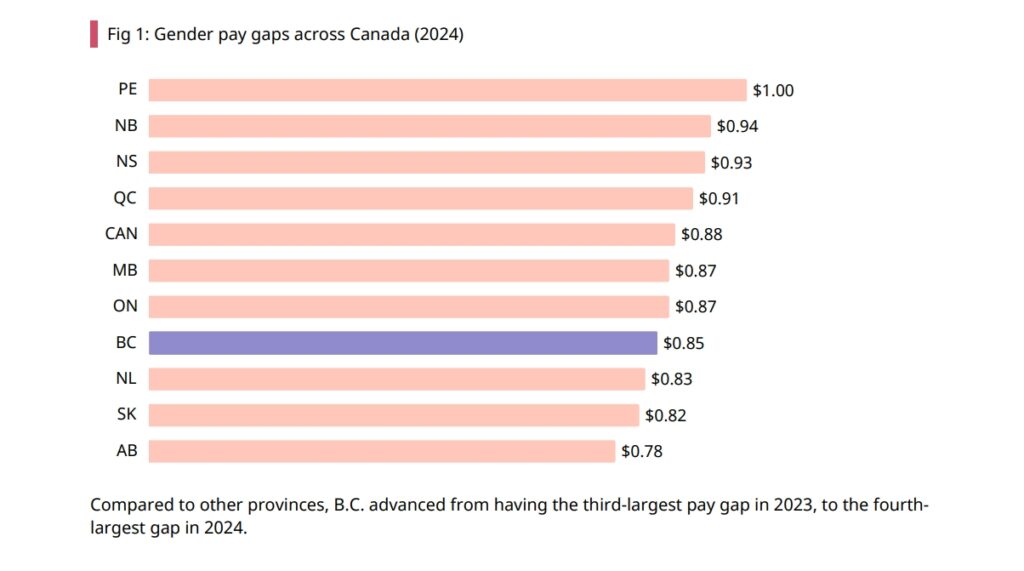Gender and equity advocates say British Columbia’s pay transparency legislation does not go far enough to close pay equity gaps, while a business group argues the law is a useful tool that will yield progress over time.
The B.C. government released its second annual pay transparency report in late May, noting “modest improvements” in the gender pay gap. The report found that in 2024, women in B.C. earned 85 cents for every dollar earned by men, a two-cent improvement from the previous year.
B.C. had the fourth-largest gender pay gap among the provinces, behind Alberta, Saskatchewan and Newfoundland and Labrador. Nationally, women earned 88 cents for every dollar paid to men.

The report identified part-time work as a key factor, noting women were twice as likely as men to work part time — jobs that typically come with lower hourly wages. Among full-time workers, the median hourly wage for women was $31.25, compared with $36 for men.
The Pay Transparency Act prohibits employers from asking job applicants about past wages and from penalizing employees who share or inquire about salary information. It also requires employers to include expected pay in job postings.
According to the report, 85 per cent of job postings from B.C.-based employers on the site Indeed included pay information, compared with just over half of postings from the rest of Canada.
Since November 2023, all B.C. employers with 1,000 or more workers have been required to submit annual reports on gender pay gaps. That requirement will expand to employers with 300 or more workers in November 2025, and to those with 50 or more employees in November 2026.
Humera Jabir, a staff lawyer with West Coast LEAF, a gender and human rights advocacy organization, said the legislation falls far short of what’s needed to meaningfully address pay inequity.
“We have not seen improvement for the most marginalized people in our economy,” said Jabir. “And that should be a concern for everyone.”
The report acknowledged the pay gap is wider for Indigenous and racialized women, both of whom earned 19 per cent less than men on average in 2024, compared to a 15 per cent gap for all women. Women with disabilities earned 18 per cent less. Transgender women earned as much as 61 per cent less than cisgender men in some cases.
Jabir said the current reporting requirements only apply to the B.C. Public Service Agency and larger organizations, leaving out many workers most affected by pay inequality.
About 170 B.C. employers met the requirement to publish reports in 2024, with the province reporting an 80 per cent compliance rate.
Jabir said she welcomed protections for workers who raise concerns under the Act, but noted there are no penalties or enforcement mechanisms for employers that fail to comply.
“There’s no teeth to the legislation that requires organizations or companies to do anything to address the discrimination we know exists,” she said. “This is a form of legislation that appears to be doing something, when actually, it does nothing at all.”
The province said it received two reports in 2024 of employers restricting staff from discussing pay.
“The Pay Transparency Unit confirmed with the complainants that employers are not allowed to impose such restrictions, whether through policy or other means,” the report said.
The report also noted 138 letters were sent to employers reminding them to include expected pay ranges in job postings. It said “most” complied after receiving the letters.
Alex McMillan, interim CEO of the B.C. Chamber of Commerce, said the law is a helpful tool for businesses seeking to close gender pay gaps.
“What can be measured, can be managed,” said McMillan. “We have to understand where we’re at in order to make progress.”
He said the legislation, introduced in 2023, is still in its early stages.
“I think we need to give it some time before we determine that it’s not strong enough,” said McMillan. “At this time, the B.C. Chamber doesn’t feel there are significant gaps in the legislation, but we also need time to adjust and evaluate.”
McMillan said the Chamber was consulted by the government in the law’s development. Privacy for individuals and employers, along with competitiveness, were key concerns raised by members, he said. He believes the government struck a “good balance.”
He added that while large companies are well equipped to comply, the reporting requirements could become “onerous” for smaller firms as the rules expand.
The province’s report said the most significant gains in closing the gender pay gap were found in the agriculture, forestry, fishing and hunting sector; the mining, quarrying, and oil and gas extraction sector; and wholesale trade.
It also included recommendations for employers, including improved gender data collection, expanding eligibility for overtime pay to include more women and non-binary workers, and monitoring gender representation across all pay levels.






